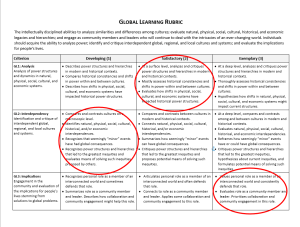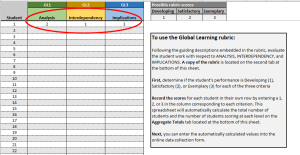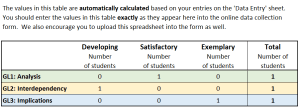Assessment
Global LearningGlobal Learning Resources
There are two resources available for your use in this study. Both were sent to you via email, but can also be downloaded below. Detailed, step-by-step instructions are also provided in the drop-down box below.
![]() Global Learning Rubric
Global Learning Rubric![]() Global Learning Assessment Data Spreadsheet
Global Learning Assessment Data Spreadsheet
Global Learning Study Timeline
Submissions for fall 2022 courses are due by January 31, 2023. Submissions for spring 2023 courses are due by June 9, 2023.
Global Learning Links
Detailed, step-by-step instructions are also provided in the drop-down box below.
![]() Click here to begin your Global Learning data submission
Click here to begin your Global Learning data submission
![]() Click here if you would like to view a copy of the questions asked for the Global Learning data submission before entering them online
Click here if you would like to view a copy of the questions asked for the Global Learning data submission before entering them online
DETAILED INSTRUCTIONS
Step 1. Choosing an Assignment
In the General Education context, global learning is the intellectually disciplined ability to analyze similarities and differences among cultures; evaluate natural, physical, social, cultural, historical, and economic legacies and hierarchies; and engage as community members and leaders who will continue to deal with the intricacies of an ever-changing world. Individuals should acquire the ability to analyze power; identify and critique interdependent global, regional, and local cultures and systems; and evaluate the implications for people’s lives. Since your course is aligned with the General Education Global Learning learning objective, it should already include activities or assignments that promote and develop these skills. Most important of all, the assignment you select for the purposes of this assessment study should ask students to demonstrate Global Learning.
-
- When choosing from available assignments, best practice suggests those assignments that are more valuable in a student’s overall grade are typically better in an assessment context as students take them more seriously. This leads to a more authentic demonstration of their skills. We typically advise assignments to be at least 10% of a student’s grade.
- Also, culminating assignments such as final projects, presentations, papers, pieces, etc. are typically the best. Still, you should use the assignment best aligned with the Global Learning objective, which will provide students with an opportunity to show their abilities.
- Finally, it is best practice to use an already existing assignment rather than create a new one solely for the purpose of the assessment study.
Step 2. Applying the Rubric
The Global Learning rubric was designed by Penn State faculty to be relevant across disciplines. It focuses on three criteria:
-
- ANALYSIS – This criterion addresses the analysis of power structures and dynamics in natural, physical, social, cultural and economic systems.
- INTERDEPENDENCY – This criterion concerns identifying and critiquing interdependent global, regional, and local cultures and systems.
- IMPLICATIONS – This criterion is about engagement in the community and evaluation of the implications for people’s lives stemming from solutions to global problems.
Each of these criteria should be individually evaluated on a simple three-point scale: Developing, Satisfactory or Exemplary.
-
- Developing – Inadequate, superficial, somewhat effective, sometimes appropriate, includes some errors
- Satisfactory – Mostly adequate, relevant, mostly effective, mostly appropriate, few errors
- Exemplary – Beyond adequate, comprehensive, effective, appropriate, virtually error-free
In the example marked-up rubric above, the student’s work has been assessed as Satisfactory on ANALYSIS, Developing on INTERDEPENDENCY, and Exemplary on IMPLICATIONS. This would result in that student receiving scores of 2, 1, and 3, respectively. In the screenshot below, these scores have been entered into the provided spreadsheet. You can repeat this process for all of the student work you plan to evaluate for the assessment study.
Step 3. Submitting Your Scores
Submitting your rubric scores is quick and easy. Just log in to our online form (click here or use the link in your email) and enter aggregate numbers for each performance level and each criterion. If you have kept track of your rubric scores in the provided spreadsheet, the spreadsheet will do all the calculations for you. To access the aggregate scores, click on the second tab at the bottom of the spreadsheet labeled “Aggregate Totals” as pictured below.
Once you have navigated to the “Aggregate Totals” tab, you will see a table that looks like the screenshot below. Take the numbers there and enter them into the online form. You can access the online form via the link you received in your email or click here.
Once you have entered your rubric scores into the online form and completed the additional few questions there, your work is complete!
FREQUENTLY ASKED QUESTIONS
Is participation mandatory?
Participation in the study, in the strictest sense, is not mandatory, but it is probably not appropriate to consider it elective either. Penn State faculty own the General Education curriculum and its delivery, and assessment of General Education is a requirement supported by the Faculty Senate and by our accreditors. In other words, we have an obligation as an institution to engage in the assessment of Gen Ed, and this study is one of the ways Penn State does so. You can elect not to participate but doing so abdicates that shared responsibility.
Which of my courses is a Global Learning course?
If you are teaching a Global Learning course in fall 2022 or spring 2023, you are invited to participate in this study. Fall course instructors will receive their invite on August 31, 2022; spring instructors will receive theirs in January 2023. Your invitation will name the specific course or courses that can be used. You can also easily look your courses up via the Undergraduate Bulletin. Once you have found your course, scroll down to see the various attributes or endorsements listed there.
Why does my course have this particular General Education Learning Objective?
When a course is proposed (or recertified) as a General Education course, 2-4 General Education Learning Objectives must be selected. The proposal requires justification and examples of how the course will meet the selected objectives. Curricular proposals are available in the Curriculum Archives if you would like to look at the course proposal and better understand the intentions when the course was proposed. The course proposal does provide examples of how the Learning Objective may be assessed, but it is only a suggestion, it is not required that you do it that way.
I’m teaching multiple Global Learning courses – which do I use?
If you happen to be teaching multiple Gen Ed Global Learning courses, or multiple sections of a given course, you are not expected to apply the rubric in all of those courses, or across all of your students. Your invitation will specify the courses selected for participation. If you have multiple Global Learning courses or multiple sections of the same course – please select whichever is most convenient to you by virtue of your course structure or enrollments. You only need to assess one section of one course.
I have misplaced my email invitation and I teach a course or multiple courses that meet both learning objectives – how do I know which study I’ve been invited to participate in?
You can reach out to the Office of Planning, Assessment, and Institutional Research at assessment@psu.edu for this information.
The assignment I want to use happens late in the semester. Can I still participate?
We encourage instructors to select culminating assignments taught near the end of the semester. The submission deadline is January 31, 2023, for courses taught in fall 2022 and June 8, 2023, for courses taught in spring 2023. You can submit your scores anytime up until the appropriate semester deadline.
All of my assignments are multiple choice. How do I apply the rubric?
Please reach out to assessment@psu.edu to discuss your options for participation.
Are we being compensated for participating?
Unfortunately, we have no funding to provide at this time, though we acknowledge and understand that this may impact your participation. With this in mind, we worked hard to make your participation as easy as possible. Assessment microgrants are available to support your program assessment efforts.




